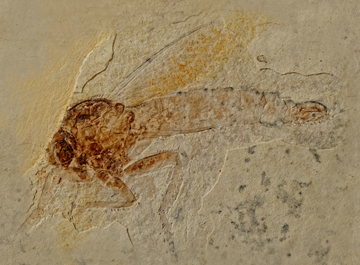Abstract
Archisargidae, an extinct family of the suborder Brachycera, are traditionally attributed to the infraorder Stratiomyomorpha (Oberprieler & Yeates, 2012). The type genus, Archisargus Rohdendorf, 1938, is a small group including only four species from two well-known localities, the Karatau Formation of Kazakhstan and the Jiulongshan Formation of China. Rohdendorf (1938) erected the genus based on the species Archisargus pulcher from the Karatau Formation of Kazakhstan, and assigned it to Stratiomyidae. Hennig (1954) questioned Rohdendorf’s assignment and pointed out that the characters of the Stratiomyidae were absent, but he didn’t propose an appropriate placement for this genus. Rohdendorf (1962) reconsidered the systematic position of the genus and established the new family Archisargidae based on the genus. In fact, the description of the Archisargus was not informative due to the incomplete preservation of the type specimen (only Sc and R were mentioned) (Rohdendorf, 1938). Mostovski (1997) re-described the type specimen of Archisargus pulcher, clarified the status of the genus, and described a second species, Archisargus maximus, which was also from Karatau, Kazakhstan. A decade later, Zhang et al. (2007) described two older species from the Middle Jurassic of Daohugou, China. The Daohugou locality is well-known for its diverse fossil insects, representing an important diversification center of insects during the Mesozoic Era (Ren et al., 2009; Wang et al., 2010, 2012; Gao et al., 2012; Gu et al., 2012; Meng et al., 2017; Ren et al., 2019). Herein, we describe a new species, Archisargus aequinervus sp. nov., from this locality. Additionally, a key to species of the genus is provided.
References
Gao, T.P., Shih, C.K., Xu, X., Wang, S. & Ren, D. (2012) Mid-Mesozoic flea-like ectoparasites of feathered or haired vertebrates. Current Biology, 22, 732–735.
https://doi.org/10.1016/j.cub.2012.03.012
Gu, J.J., Montealegre, Z. F., Robert, D., Engel, M.S., Qiao, G.X. & Ren, D. (2012) Wing stridulation in a Jurassic katydid (Insecta, Orthoptera) produced low-pitched musical calls to attract females. Proceedings of the National Academy of Sciences USA, 109, 3868–3873.
https://doi.org/10.1073/pnas.1118372109
Hennig, W. (1954) Flugelgeader und system der Dipteren unter Berücksichtigung der aus dem Mesozoikum beschriebene Fossilien. Beiträge zur Entomologie, 4, 245–388.
https://doi.org/10.21248/contrib.entomol.4.3-4.245-388
Meng, Q.M., Labandeira, C.C., Ding, Q.L. & Ren, D. (2019) The natural history of oviposition on a ginkgophyte fruit from the Middle Jurassic of northeastern China. Insect Science, 26 (1), 171–179.
https://doi.org/10.1111/1744-7917.12506
Mostovski, M.B. (1996a) To the knowledge of Archisargoidea (Diptera, Brachycera). Families Eremochaetidae and Archisargidae. Russian Entomological Journal, 5, 117–124.
Mostovski, M.B. (1996b) New species of the genus Mesosolva Hong, 1983 (Diptera, Archisargidae) from the Jurassic of Kazakhstan and Mongolia. Museum of Northern Arizona Bulletin, 60, 329–332.
Mostovski, M.B. (1997) To knowledge of fossil flies of the superfamily Archisargoidea (Diptera: Brachycera). Paleontological Journal, 31, 72–80.
Oberprieler, S.K. & Yeates, D.K. (2012) Calosargus talbragarensis new species: the first brachyceran fly from the Jurassic of Australia (Diptera, Archisargidae). Journal of Paleontology, 86, 641–645.
https://doi.org/10.1666/11-126R.1
Ren, D., Labandeira, C.C., Santiago-Blay, J.A., Rasnitsyn, A., Shih, C.K., Bashkuev, A., Logan, M.A., Hotton, C.L. & Dilcher, D. (2009) A probable pollination mode before angiosperms: Eurasian, long-proboscid scorpionflies. Science, 326, 840–847.
https://doi.org/10.1126/science.1178338
Ren, D., Shih, C.K., Gao, T.P., Wang, Y.J. & Yao, Y.Z. (2019) Rhythms of Insect Evolution—Evidence from the Jurassic and Cretaceous in Northern China. WILEY Blackwell, New York, 707pp.
https://doi.org/10.1002/9781119427957
Rohdendorf, B.B. (1938) Dipterous insects of the Mesozoic Karatau. I. Brachycera and part of the Nematocera. Trudy Paleontologicheskogo Instituta Akademii Nauk SSSR, 7, 29–67 [In Russian].
Rohdendorf, B.B. (1962) Order Diptera, Flies. In: Rohdendorf, B.B. (Ed.), Fundamentals of Paleontology Volume 9. Izdatel’stvo Akademiia Nauk, Moscow, 307–345 [In Russian].
Shcherbakov, D.E., Lukashevich, E.D. & Blagoderov, V.A. (1995) Triassic Diptera and the initial radiation of the order. International Journal of Dipterological Research, 6, 75–115.
Wang, Y.J., Labandeira, C.C., Shih, C.K., Ding, Q., Wang, C., Zhao, Y.Y. & Ren, D. (2012) Jurassic mimicry between a hangingfly and a ginkgo from China. Proceedings of the National Academy of Sciences USA, 109, 20514–20519.
https://doi.org/10.1073/pnas.1205517109
Wang, Y.J., Liu, Z.Q., Wang, X., Shih, C.K., Zhao, Y.Y., Engel, M.S. & Ren, D. (2010) Ancient pinnate leaf mimesis among lacewings. Proceedings of the National Academy of Sciences USA, 107, 16212–16215.
https://doi.org/10.1073/pnas.1006460107
Wootton, R.J. & Ennos, A.R. (1989) The implications of function on the origin and homologies of the dipterous wing. Systematic Entomology, 14, 507–520.
https://doi.org/10.1111/j.1365-3113.1989.tb00300.x
Zetterstedt, J.W. (1842) Diptera scandinaviae disposita et descripta. Officina Lund bergiana, Lundae, 440 pp.
Zhang, J.F. (2015) Archisargoid flies (Diptera, Brachycera, Archisargidae and Kovalevisargidae) from the Jurassic Daohugou biota of China, and the related biostratigraphical correlation and geological age. Journal of Systematic Palaeontology, 13, 857–881.
https://doi.org/10.1080/14772019.2014.960902
Zhang, J.F. (2017) New findings of Flagellisargus J. Zhang, 2012 (Diptera, Brachycera, Archisargidae), with discussion of the placements of some controversial taxa. Deutsche Entomologische Zeitschrift, 64, 111.
https://doi.org/10.3897/dez.64.13550
Zhang, K.Y., Yang, D., Ren, D. & Shih, C.K. (2007a) The earliest species of the extinct genus Archisargus from China (Diptera: Brachycera: Archisargidae). Annales Zoologici, 57, 827–832.
https://doi.org/10.3161/000345407783742006
Zhang, K.Y., Yang, D., Ren, D. & Shih, C.K. (2007b) The oldest Calosargus Mostovski, 1997 from the Middle Jurassic of China (Diptera: Brachycera: Archisargidae). Zootaxa, 1645, 1–17.
https://doi.org/10.11646/zootaxa.1645.1.1
Zhang, K.Y., Yang, D., Ren, D. & Shih, C.K. (2010) An evolutional special case in the lower Orthorrhapha: some attractive fossil flies from the Middle Jurassic of China (Insecta: Diptera: Brachycera). Zoological Journal of the Linnean Society, 158, 563‒572.

